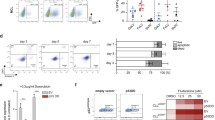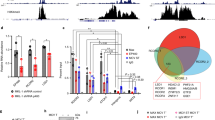Abstract
The tumor susceptibility gene, TSG101, has been identified as a candidate tumor suppressor gene. We have examined the expression of TSG101 in Burkitt lymphoma cell lines. Several aberrant messages were detected in all cell lines. Aberrant splice donor sites are located within exon 1 at positions 132, 154, 172 and 284. Splice acceptors are located at positions 847 and 1054 within exon 5. The aberrant messages are coexpressed with a normal message and could be the result of additional splicing reactions of the mature message that behaves as an intermediate. The normal message codes for 46 kDa protein (TSG101A). One aberrant message joins in frame nucleotides 283 – 1055 and codes for a protein isoform of 17 kDa (TSG101B), as demonstrated by in vitro translation assays. The TSG101B isoform lacks the leucine zipper near the C-terminus, a transcriptional repressor domain, and retains most of the N-terminal region which has homology to E2 ubiquitin regulatory enzymes and the CROC-1 transcriptional regulator. The TSG101B isoform was detected in sixteen out of twenty-two (72%) BL cell lines, but not in normal lymphoid populations. The presence of two TSG101 isoforms with different dimerization potential opens up a new level of regulation of the TSG101 proteins possibly affecting cell cycle regulation.
This is a preview of subscription content, access via your institution
Access options
Subscribe to this journal
Receive 50 print issues and online access
$259.00 per year
only $5.18 per issue
Buy this article
- Purchase on Springer Link
- Instant access to full article PDF
Prices may be subject to local taxes which are calculated during checkout







Similar content being viewed by others
References
Alber T. . 1992 Curr. Opin. Genet. Dev. 2: 205–210.
Chomczynski P and Sacchi N. . 1987 Anal. Biochem. 162: 156–162.
Ehlin-Henrikson B, Manneborg-Sandlund A and Klein G. . 1987 Int. J. Cancer 39: 211–218.
Fearon ER. . 1997 Science 278: 1043–1050.
Feduchi E, Gallego MI and Lazo PA. . 1994 Int. J. Cancer 58: 855–859.
Gayther SA, Barski P, Batley SJ, Li L, de Foy K, Cohen SN, Ponder B and Caldas C. . 1997 Oncogene 15: 2119–2126.
Haber D and Harlow E. . 1997 Nature Genet. 16: 320–321.
Hayashi S, Tanimoto K, Hajiro-Nakanishi K, Kurosomi M, Higashi Y, Imai K, Suga K and Nakachi K. . 1997 Cancer Res. 57: 1981–1985.
Hershko A. . 1997 Curr. Opin. Cell Biol. 9: 788–799.
Kinzler KW and Vogelstein B. . 1996 Cell 87: 159–170.
Koonin EV and Abagyan RA. . 1997 Nat. Genet. 16: 330–331.
Lee MP and Feinberg AP. . 1997 Cancer Res. 57: 3131–3134.
Li L and Cohen SN. . 1996 Cell 85: 315–329.
Li L, Li X, Francke U and Cohen SN. . 1997 Cell 88: 143–154.
Lin PM, Liu TC, Chang JG, Chen TP and Lin SF. . 1998 Br. J. Haematol. 102: 753–758.
Magrath I. . 1990 Adv. Cancer Res. 53: 133–270.
Marklund U, Brattsand G, Osterman O, Ohlsson P and Gullberg M. . 1993 J. Biol. Chem. 268: 25671–25680.
Oh Y, Proctor ML, Fan YH, Su L-K, Hong WK, Fong KM, Sekido YS, Gazdar AF, Minna JD and Mao L. . 1998 Oncogene 17: 1141–1143.
Ponting CP, Cai YD and Bork P. . 1997 J. Mol. Med. 75: 467–469.
Rabbitts TH. . 1994 Nature 372: 143–149.
Rodofsky ML and Lin SL. . 1997 Gene 195: 141–149.
Roos G, Brattsand G, Landberg G, Marklund U and Gullberg M. . 1993 Leukemia 7: 1538–1546.
Sancho E, Vila MR, Sanchez-Pulido L, Lozano JJ, Paciucci R, Nadal M, Fox M, Harvey C, Bercovich B, Loukili N, Ciechanover A, Lin SL, Sanz F, Estivill X, Valencia A and Thomsom M. . 1988 Mol. Cell. Biol. 18: 576–589.
Sozzi G, Veronese ML, Negrini M, Baffa R, Cotticelli MG, Inoue H, Tornielli S, Pilotti S, De Gregorio L, Pastorini U, Pierotti MA, Ohta M, Huebner K and Croce CM. . 1996 Cell 85: 17–26.
Steiner P, Barnes DM, Harris WH and Weinberg RA. . 1997 Nature Genet. 16: 332–333.
Sun Z, Pan J, Bubley G and Balk SP. . 1997 Oncogene 18: 3121–3125.
Thomson TM, Khalid H, Lozano JJ, Sancho E and Ariño J. . 1998 FEBS Lett. 423: 49–52.
Townsley FM, Aristarkhov A, Beck S, Hershko A and Ruderman JV. . 1997 Proc. Natl. Acad. Sci. USA 94: 2362–2367.
Virgilio L, Shuster M, Gollin SM, Veronese ML, Ohta M, Huebner K and Croce CM. . 1996 Proc. Natl. Acad. Sci. USA 93: 9770–9775.
Watanabe M, Yanagi Y, Masuhiro Y, Yano T, Yoshikawa H, Yanagisawa J and Kato S. . 1998 Biochem. Biophys. Res. Commun. 245: 900–905.
Xie W, Li L and Cohen SN. . 1998 Proc. Natl. Acad. Sci. USA 95: 1595–1600.
Zhong Q, Chen C-F, Chen Y, Chen P-L and Lee W-H. . 1997 Cancer Res. 57: 4225–4228.
Zimonjic D, Druck T, Ohta M, Kastury K, Coce CM, Popescu N and Huebner K. . 1997 Cancer Res. 57: 1166–1170.
Acknowledgements
MF and SL-B were supported by fellowships from Instituto de Salud Carlos III and Comunidad de Madrid respectively. This work was supported by grants FIS95/0413 and FIS 98/0313 from the Fondo de Investigación Sanitaria and Comunidad de Madrid to PAL.
Author information
Authors and Affiliations
Rights and permissions
About this article
Cite this article
Ferrer, M., López-Borges, S. & Lazo, P. Expression of a new isoform of the tumor susceptibility TSG101 protein lacking a leucine zipper domain in Burkitt lymphoma cell lines. Oncogene 18, 2253–2259 (1999). https://doi.org/10.1038/sj.onc.1202551
Received:
Revised:
Accepted:
Published:
Issue Date:
DOI: https://doi.org/10.1038/sj.onc.1202551



